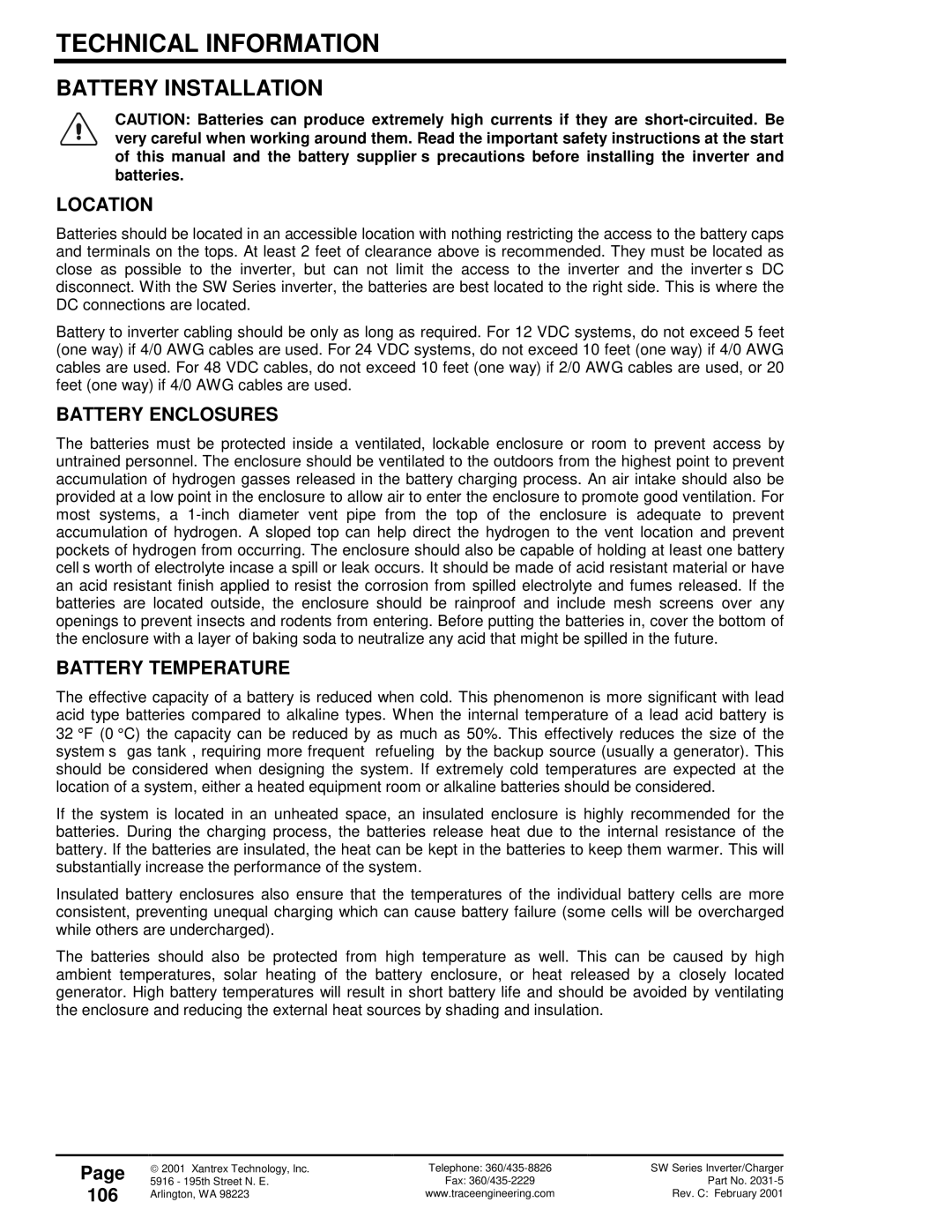
TECHNICAL INFORMATION
BATTERY INSTALLATION
CAUTION: Batteries can produce extremely high currents if they are
LOCATION
Batteries should be located in an accessible location with nothing restricting the access to the battery caps and terminals on the tops. At least 2 feet of clearance above is recommended. They must be located as close as possible to the inverter, but can not limit the access to the inverter and the inverter’s DC disconnect. With the SW Series inverter, the batteries are best located to the right side. This is where the DC connections are located.
Battery to inverter cabling should be only as long as required. For 12 VDC systems, do not exceed 5 feet (one way) if 4/0 AWG cables are used. For 24 VDC systems, do not exceed 10 feet (one way) if 4/0 AWG cables are used. For 48 VDC cables, do not exceed 10 feet (one way) if 2/0 AWG cables are used, or 20 feet (one way) if 4/0 AWG cables are used.
BATTERY ENCLOSURES
The batteries must be protected inside a ventilated, lockable enclosure or room to prevent access by untrained personnel. The enclosure should be ventilated to the outdoors from the highest point to prevent accumulation of hydrogen gasses released in the battery charging process. An air intake should also be provided at a low point in the enclosure to allow air to enter the enclosure to promote good ventilation. For most systems, a
BATTERY TEMPERATURE
The effective capacity of a battery is reduced when cold. This phenomenon is more significant with lead acid type batteries compared to alkaline types. When the internal temperature of a lead acid battery is 32 ° F (0 ° C) the capacity can be reduced by as much as 50%. This effectively reduces the size of the system’s “gas tank”, requiring more frequent “refueling” by the backup source (usually a generator). This should be considered when designing the system. If extremely cold temperatures are expected at the location of a system, either a heated equipment room or alkaline batteries should be considered.
If the system is located in an unheated space, an insulated enclosure is highly recommended for the batteries. During the charging process, the batteries release heat due to the internal resistance of the battery. If the batteries are insulated, the heat can be kept in the batteries to keep them warmer. This will substantially increase the performance of the system.
Insulated battery enclosures also ensure that the temperatures of the individual battery cells are more consistent, preventing unequal charging which can cause battery failure (some cells will be overcharged while others are undercharged).
The batteries should also be protected from high temperature as well. This can be caused by high ambient temperatures, solar heating of the battery enclosure, or heat released by a closely located generator. High battery temperatures will result in short battery life and should be avoided by ventilating the enclosure and reducing the external heat sources by shading and insulation.
Page
106
2001 Xantrex Technology, Inc. | Telephone: | SW Series Inverter/Charger |
5916 - 195th Street N. E. | Fax: | Part No. |
Arlington, WA 98223 | www.traceengineering.com | Rev. C: February 2001 |
